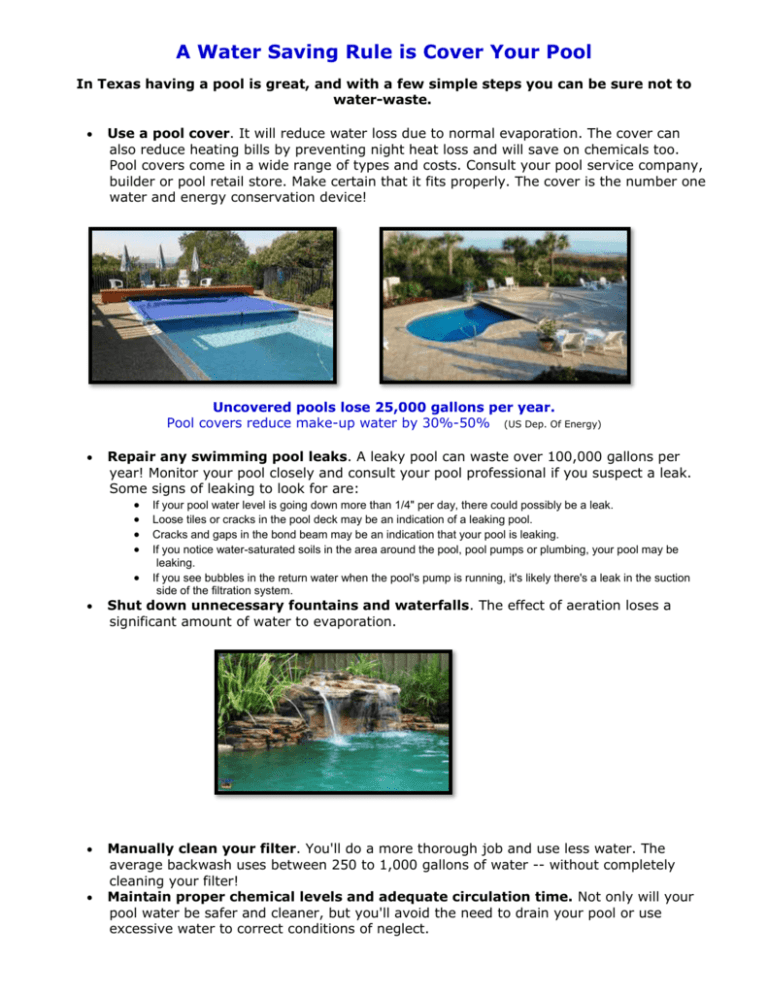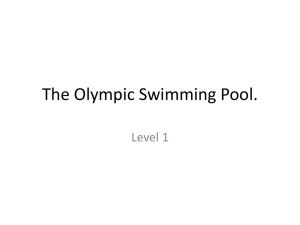July - Pool Water Saving Tips
advertisement

A Water Saving Rule is Cover Your Pool In Texas having a pool is great, and with a few simple steps you can be sure not to water-waste. Use a pool cover. It will reduce water loss due to normal evaporation. The cover can also reduce heating bills by preventing night heat loss and will save on chemicals too. Pool covers come in a wide range of types and costs. Consult your pool service company, builder or pool retail store. Make certain that it fits properly. The cover is the number one water and energy conservation device! Uncovered pools lose 25,000 gallons per year. Pool covers reduce make-up water by 30%-50% (US Dep. Of Energy) Repair any swimming pool leaks. A leaky pool can waste over 100,000 gallons per year! Monitor your pool closely and consult your pool professional if you suspect a leak. Some signs of leaking to look for are: If your pool water level is going down more than 1/4" per day, there could possibly be a leak. Loose tiles or cracks in the pool deck may be an indication of a leaking pool. Cracks and gaps in the bond beam may be an indication that your pool is leaking. If you notice water-saturated soils in the area around the pool, pool pumps or plumbing, your pool may be leaking. If you see bubbles in the return water when the pool's pump is running, it's likely there's a leak in the suction side of the filtration system. Shut down unnecessary fountains and waterfalls. The effect of aeration loses a significant amount of water to evaporation. Manually clean your filter. You'll do a more thorough job and use less water. The average backwash uses between 250 to 1,000 gallons of water -- without completely cleaning your filter! Maintain proper chemical levels and adequate circulation time. Not only will your pool water be safer and cleaner, but you'll avoid the need to drain your pool or use excessive water to correct conditions of neglect. Plug the overflow line when the pool is in use and always when adding water. Keep the pool water in the pool. Plant a windbreak. Wind blowing across the surface of the pool causes additional evaporation. A windbreak can help you conserve water as well as energy costs. Reevaluate the frequency of backwashing if your pool has no separation tank. Most people backwash more frequently than necessary. This wastes water. Some pool filters do not have to be backwashed at all; they can be taken apart and cleaned, even though this process is less convenient. Topping Off. When topping off, use a hose timer to avoid overfilling. Add a few inches as needed on your scheduled watering day to maintain constant water levels. Auto-fill devices can malfunction and add water unnecessarily. Using a hose makes it easier to tell if a leak develops or the pool level changes dramatically. Refill Right. Spring and Fall are the best times to refill your pool. Refilling then won’t put a strain on the water system or affect your wastewater average, which is calculated between November and March. Ask your plumber about installing a submeter to monitor water use. Turn off the tile-spray device on your automatic pool cleaner. Its splashing invites evaporation losses, and overspraying can send water right out of the pool! A good deal of that spray evaporates before it hits the tile.





